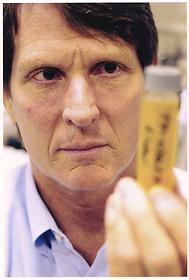Exhibition Images
Image 13 of 33
The New Forensic Science
Brian Andresen with a sample vial, July 2004
Dr. Andresen had to find some way to detect minute concentrations of Pavulon in long-buried victims—a method of teasing the drug out of decomposed tissue. After weeks of intense 16-hour days, Andresen successfully extracted Pavulon from pig livers using polystyrene divinyl benzene, a polymer originally developed to detect the residue of chemical weapons in body tissues. Andresen then used the same technique on exhumed tissues from Saldivar's patients.
Courtesy of Anthony Pidgeon
